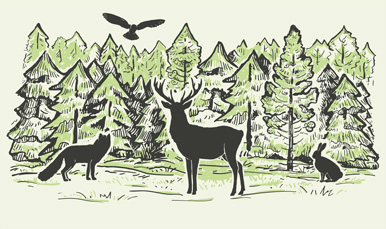
Most people enjoy sunsets, nature walks, and the season’s first snow, but they find insects and thunderstorms pesky, even perilous. Such is the difference between wilderness and the subject of School of International Service professor Paul Wapner’s latest book: wildness.
“Wildness is not simply a place but a state of mind,” says the environmental scholar. “It stems etymologically from ‘self-willed’—the idea that there are things operating independently of human interest, human design, human power.”
A digestible and accessible little volume, Is Wildness Over? posits that in our centuries-long quest for stability, comfort, and predictability, humans have “tried to tame or otherwise control wildness.” And the consequences—calving glaciers, devastating wildfires, record-breaking heat waves, and rising oceans—have been catastrophic.
“People throw environmental harm onto the lives of others rather than deal with it themselves,” Wapner writes. “They toss it across space, time, and species. They send it to other communities, the future, and into the lives of other creatures. In each case, some benefit while others suffer. Too many ignore those on the receiving end. They turn a deaf ear to the vulnerable and politically weak, whether human or nonhuman. In this sense, climate change and mass extinction represent more than technical problems. They are atmospheric and terrestrial expressions of injustice.”
Wapner likens wildness to energy in that “it can’t be created or destroyed.” So when we banish it from our comfortable, climate-controlled homes, “it doesn’t just disappear or evaporate; we actually push it in two directions.”
First, we push it horizontally, downstream, to those who are less advantaged than us. Take nuclear waste.
“We haven’t solved the problem; we just displace it,” Wapner says. “We push it across time and say, ‘Oh, we’ll bury it in canisters that won’t last as long as the waste itself. And good luck, future generations.’”
We also push wildness vertically, catapulting unpredictability and danger up to the global level.
Climate change, biodiversity loss, deforestation, and other global environmental dilemmas result from the displacement of wildness from our immediate lives, forcing it to accumulate at the planetary level.
Toward the end of the book, Wapner poses a question to readers: Are we, the privileged, willing to approach our relationship with nature in a fundamentally different way? He calls this process rewilding.
“I’m not asking for us to eschew electricity and comfort completely, but I do think there’s space for us to experience a little more discomfort and a little less scratching every itch we have by turning to fossil fuels and sanitizing our world. And every animal that sort of bothers us, we’ll just either wipe it out or push it away from us. I think that’s at the root of the problem.”
During the pandemic, Wapner has been hunkering down with his wife in New Mexico—where rewilding involves slithering into coexistence with rattlesnakes.
“On the one hand, I’m thankful for the rattlers; they tell me that the land is healthy—it can support all kinds of critters. We also have coyotes, rabbits, lizards, and occasionally bears and elk on the land. We are blessed with radical otherness in our midst,” he says. “On the other hand, I’m terrified of being bitten by a rattlesnake. A snake’s indifference to me and my designs scares me. I’m working on living with the dual dimensions of wildness. It sounds crazy, but doing so is making me more awake to the world and my life.”